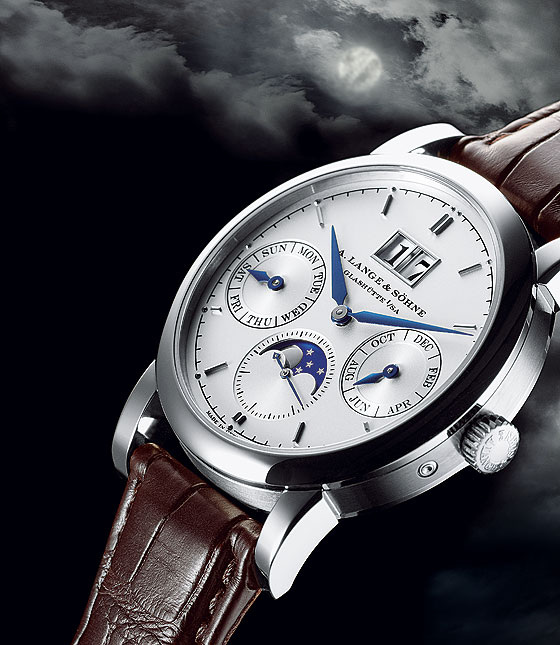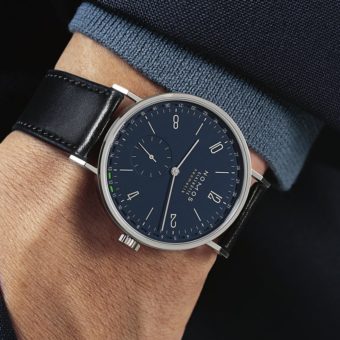
In 2010, A. Lange & Söhne added an annual calendar to the long list of complications in its portfolio. This type of calendar adjusts itself automatically for the varying lengths of the months with 30 or 31 days: it “knows” which are which. An annual calendar is stumped only by February, which, of course, has either 28 or 29 days. When March begins, the owner must therefore move the date forward to the first of that month. An annual calendar is so named because it needs adjustment just once a year.
The company already had a perpetual calendar in its line-up, the Langematik Perpetual, when it launched the Saxonia Annual Calendar. Both watches have very similar, self-winding movements, and both have the same highly precise moon-phase display, which will be off by just one day after 122 years. The perpetual calendar nonetheless costs almost twice as much as the annual calendar. The Langematik Perpetual does have a couple of attractions that the Saxonia lacks: a leap-year indicator, found on many perpetual calendars, and a 24-hour display.
The Annual Calendar is more attractive than its Perpetual counterpart, thanks in part to the absence of these features. Eliminating both the small leap-year display, superimposed on the Perpetual’s month subdial, and the 24-hour display, which shares a subdial with the Perpetual’s day indicator, makes the Annual Calendar’s dial cleaner and easier to read, and also gives perfect east-west symmetry to the dial. A love of detail is evident in many places, such as the stalk-shaped indices, which are faceted on all four sides; the hands, which arch gently toward their tips; and the perfectly polished little moon that adorns the moon-phase disk.

The designers of the Saxonia Annual Calendar have given it a very harmonious appearance; but because of precisely this quality, it doesn’t look quite as distinctive as some of this manufacture’s other notable creations, such as the Lange 1 or the Zeitwerk.
Lange has also made the watch very legible: the blued hands contrast strongly with the large silver dial. And the large date, with Lange’s standard double window, can be read at a glance. The months circle spells out only every second month. The watch is available with either English or German names for the days and months. However, more than a fleeting glance is needed to read the information displayed on these two subdials, and nothing on the dial is luminous. The nonreflective treatment on the crystal, which is made of sapphire, enhances daytime legibility. The crystal is so glare-free that it’s nearly invisible.
One of the watch’s minor shortcomings is that the date display takes half an hour to switch completely to the next day’s date: it starts to advance at five minutes before midnight. If the watch hasn’t been worn for several days, the wearer can quickly bring the calendar indicators up to date by pushing buttons set into the case: the big date is adjusted by a button at 10 o’clock, the day by one at 9 o’clock, the moon-phase by one 8 o’clock, and the month by one at 3:30. Each of these little buttons is pressed with the tip of a pen-like tool, which minimizes the risk of scratching the case. The buttons are neatly inset into the satin-finished middle part of the extremely well-crafted case, so they scarcely detract from the watch’s elegant appearance. The patented “zero-reset” hand-setting mechanism not only momentarily stops the balance, but also sends the seconds hand hurrying back to its starting position at the top of its subdial (which also contains the moon-phase display). This hand and the balance instantaneously resume moving when the crown is pressed in. This practical feature, which functions like a chronograph with a zero-reset heart cam on the stem of the seconds hand, makes it easy to synchronize the watch with a time signal.

Although many watch lovers might have preferred a folding clasp, the pronged buckle is another practical detail. Thanks in part to its curved prong, this buckle cleverly guides the strap through it without the leather kinking and ensures that the strap wraps straight and flat around the wrist when the buckle is closed. An additional crossbar enhances the buckle’s stability. The wearing comfort here is better than that offered by a folding clasp because the pronged buckle is so flat and short that it can’t press uncomfortably against the skin. And, after all, a pronged buckle is really no more difficult to open and close than a belt buckle.







The case measures m in diameter and has that reassuring weight that only a gold watch can offer. I can understand why so many watch fans are bewitched by ultra-thin, ultra-light watches, but I like to feel the presence of my watch on my wrist. I also understand that m might not quite cut it with purists, but the short lugs and relatively thin waistline of 10.m attenuate the diameter. For my wrist, m might be pushing it sizewise, but I was surprised by how comfortable the watch wears. And as you can see, the watch looks perfectly proportioned on Frank s 18.m wrist (on the photos).
a nice in depth article on a beautiful looking watch!